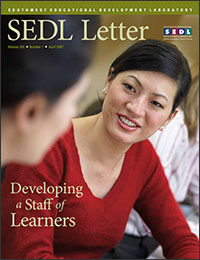Developing a Staff of Learners
For more than a decade, SEDL and other organizations such as the National Staff Development Council (NSDC) have been promoting job-embedded professional development. Incorporating such staff development has meant a shift from traditional teacher inservice training—the one-shot workshop—to a model where continuous learning is part of the job. This model uses strategies such as coaching, mentoring, peer observation, and reflection to deepen learning. Administrators become the leaders, facilitators, and role models for on-the-job learning.
In this issue of SEDL Letter, we will look at some of the forms of on-the-job professional development as well as standards of effective professional development.
We couldn't produce an issue of the magazine devoted to professional development without featuring professional learning communities (PLCs). SEDL scholar emerita Shirley Hord has been actively promoting PLCs for years. Andy Hargreaves and Dean Fink, in their book Sustainable Leadership (2006), recognized Dr. Hord as having been the first to distill the idea of a PLC and describe the qualities of a PLC. In this issue, Dr. Hord presents an overview of the characteristics of a PLC. She says that PLCs have been described in about every way imaginable, but there are well-established characteristics that define a PLC.
Also in this issue, NSDC's Stephanie Hirsh discusses the standards that have helped strengthen professional development in recent years and the companion assessment used to measure the quality of professional development programs. Noted speaker and author Mike Schmoker discusses the need for an internal culture of accountability in order to strengthen teaching as a profession and increase student achievement. Former SEDL staff member Ed Tobia, now a lecturer at Texas State University, presents an overview of SEDL's Professional Teaching and Learning Cycle. The PTLC focuses on using effective strategies to meet state standards and using student performance data to help inform instruction. It is one process that could help school staffs achieve the internal accountability that Schmoker says is necessary.
In another article, SEDL staff members Laura Shankland and Deborah Donnelly discuss how the Afterschool Training Toolkit can be used in job-embedded professional development for afterschool programs. And to keep hope alive, SEDL program associate and former principal Bill Sommers provides a few suggestions for motivating and supporting staff. We also highlight the work of SEDL's comprehensive centers, which are charged with building the capacity of states in their regions to implement the programs and goals of the No Child Left Behind Act. Finally, because even parents need professional development, we introduce five booklets written to help K–3 parents strengthen their children's crucial reading skills.
We think this issue of SEDL Letter will give readers ideas for effective professional development and encourage them to see learning as an ongoing endeavor for everyone in the school community—not just for students. 
Next Article: What is a PLC?

